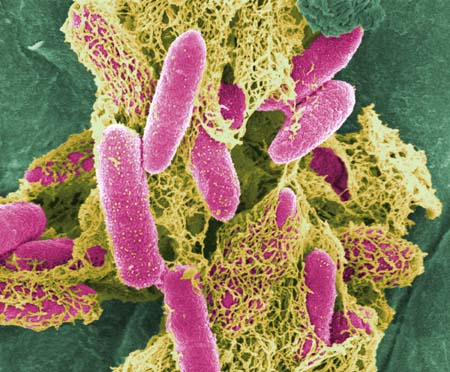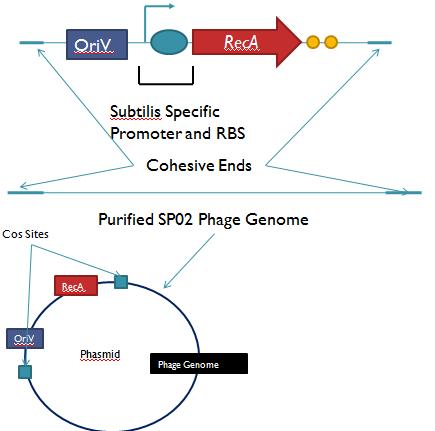Team:Caltech/Project/Phage Pathogen Defense
From 2008.igem.org
|
People
|
Phage Pathogen Defense
IntroductionThere are <math> {10^{14 |
There are many medical treatments for food-borne illnesses, the most commonly prescribed being antibiotics. Unfortunately, antibiotics are indiscriminant and lead to rapid depletion of benign bacterial populations within the intestine. Due to this fact, dietary supplements have been popularized which aim to introduce beneficial bacteria back into the gut after antibiotic treatment; these substances have been termed ‘probiotics’. Natural probiotics have two main advantages: they provide useful functions for the host and they competitively inhibit growth of pathogenic bacteria. Natural probiotics do not convey any more advantages than bacteria in a healthy human intestine. Modern synthetic biology techniques should allow us to create an engineered probiotic that goes beyond the limitations of natural probiotics. The viability of such engineered probiotics within humans has already been established [4]. As part of a collaborative effort by the Caltech iGEM team to create a novel probiotic with improved medical applications, this project focuses on engineering a pathogen defense system within E. coli..
Part I: Lambda Phage
Bacteriophage λ is a temperate phage with an E. Coli. host, λ infects E. Coli through the lamB receptor, and absence of this receptor prevents λ infection. Our project takes advantage of this aspect of bacteriophage λ to create E. Coli which are resistant to the phage, but release the phage to destroy susceptible pathogenic E. Coli. To achieve this, lamB deficient E. Coli must first express the surface protein through a constitutively active version of the gene on a plasmid. This allows the lamB deficient E. Coli to be infected by λ phage. Lysogens are selected for using antibiotic resistance, and then the plasmid possessing the lamB receptor gene is counter-selected against, producing a strain lysogenic for λ, but is immune to infection.
System Design
The system design revolves around the construction of two plasmids, both of which to be placed within E. Coli Strain JW3996-1, a strain deficient in the maltose outer membrane porin lamB, a surface protein integral to λ phage infection. One of these two plasmids is first responsible for creating JW3996-1 λ lysogens. However, creating lamB- lysogens is complicated by the fact that the JW3996-1 strain is immune to λ phage infection. Thus, to allow for λ infection, lamB must be expressed on a plasmid. The gene coding for lamB was obtained from E. Coli genomic DNA using PCR. For regulation of lamB expression, a weak constitutive promoter, J23113, and 2 weak ribosomal binding sites, B0032 and B0033, were placed upstream of the lamB gene. In the final system, the lysogens will have to be immune to infection, thus, the lamB+ plasmid will have to be cured from the JW3996-1 strain. This is proposed to be done via fusaric acid tetracycline counter-selection [4], a procedure which will allow for selective pressure against tetracycline resistance. To apply this to the lamB+ plasmid, a tetracycline resistant cassette (P1005) with a terminator (B0015) has been cloned downstream of the lamB gene.
The second plasmid which must be designed controls the induction of the lysogens to release phage into the environment. Control of this aspect of the system is vital for integration with the overall iGEM project. In general, λ lysogens stay in lysogeny until some trigger, usually cellular stress. However, we want to be able to induce the lysogens into the lytic cycle, this is done through the over expression of the E. Coli gene rscA, which has been shown to bring lysogens into the lytic phase. Currently, the rscA gene has been placed behind the luxR repressor/activator. This repressor prevents expression of rscA until activation via acyl-homo-serine lactone (AHL). However, within the final project, rscA will most likely be placed in the control of Allen's random differentiation generator. Furthermore, the final system will be similar in nature to Doug's, with a inverter after the activation of rscA, this is shown below.
Current Work
Will be updating when it is not 6 am.
Constructs
Same as above
Part II: B. Subtilis Lysogens
Basic Idea
We wish to create a phasmid, basically the lysogen genome with an E. Coli plasmid origin of replication, using B. Subtilis lysogens. This allows the phage genome to pass on as a plasmid within our engineered E. Coli, but when the plasmid is conjugated to B. Subtilis, the virus is induced and destroys the pathogens. Phasmid construction will an E Coli origin of replication with a Subtilis specific promoter in front of RecA or another inducer.
Current Progress
Three different bacteriophage lysogens and three wildtype strains of B. Subtilis has been ordered from the Bacillus Stock Center. However, efforts to induce the bacteriophage from the lysogens with UV exposure has proved to be futile thus far, however, this was possibly due to a contamination of the lysogen stocks. The strains have been reordered and B. Subtilis lysogen induction with UV occurring soon, most likely the week of 8/4.
}} "
"




